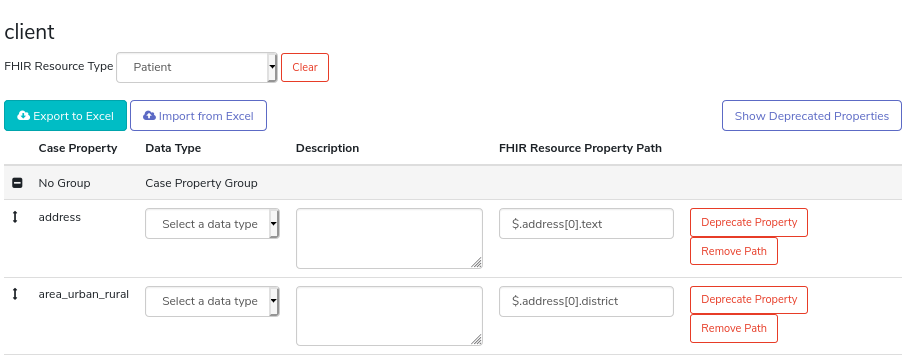CommCare FHIR Integration
CommCare HQ offers three ways of sharing data over FHIR:
Data forwarding allows CommCare cases to be sent to remote FHIR services.
The FHIR Importer fetches resources from a remote FHIR API and imports them as CommCare cases.
The FHIR API exposes CommCare cases as FHIR resources.
FHIR-related functionality is enabled using the “FHIR integration” feature flag.
Mapping case properties using the Data Dictionary
The FHIR Resources to be sent by data forwarding, or shared by the FHIR API, are configured using the Data Dictionary. (Under the “Data” menu, choose “View All”, and navigate to “Data Dictionary”)
The Data Dictionary is enabled using the “Data Dictionary” feature flag.

For example, let us imagine mapping a “person” case type to the “Patient” FHIR resource type. You would select the “person” case type from the list of case types on the left.
Set the value of the “FHIR ResourceType” dropdown to “Patient”.
The Data Dictionary supports simple mapping of case properties. You will see a table of case properties, and a column titled “FHIR Resource Property Path”. This is where to enter the JSONPath to the resource property to set.
An example will help to illustrate this: Imagine the “person” case type has a “first_name” case property, and assume we want to map its value to the patient’s given name.
Check the structure of a FHIR Patient on the HL7 website.
Note Patient.name has a cardinality of “0..*”, so it is a list.
Check the HumanName datatype.
Note Patient.name.given also has a cardinality of “0..*”.
Refer to JSONPath expression syntax to see how to refer to Patient’s first given name. … You will find it is
$.name[0].given[0]. (To become more familiar with JSONPath, playing with the JSONPath Online Evaluator can be fun and useful.)Fill the value “$.name[0].given[0]” into the “FHIR Resource Property Path” field for the “first_name” case property.
You can test this using a tool like the Postman REST Client or the RESTED Firefox add-on / Chrome extension, call the CommCare FHIR API endpoint for a patient. e.g.
https://www.commcarehq.org/a/<domain>/fhir/R4/Patient/<case-id>(You will need to configure the REST client for API key authentication.) You will get a result similar to the following:{ "id": "<case-id>", "resourceType": "Patient", "name": [ { "given": [ "Jane" ] } ] }
Use JSONPath to map the rest of the case properties you wish to represent in the Patient resource. For a simpler example, a “date_of_birth” case property would be mapped to “$.birthDate”.
Playing with the JSONPath Online Evaluator can be fun and useful way to become more familiar with JSONPath.
Advanced mapping using the Admin interface
The Data Dictionary is meant to offer as simple an interface as possible for mapping case properties to FHIR resource properties. But what about FHIR resource properties whose values are not stored in case properties? Or FHIR resource properties whose data types are not the same as their corresponding case properties?
This can done using the Admin site, and is accessible to superusers.
Mappings are configured using ValueSource definitions. For more information about ValueSource, see the Value Source documentation.
Open the Admin site, and navigate to “FHIR” > “FHIR resource types”.
There is a list of case types that have been mapped to resource types. Filter by domain if the list is long. Select the resource-type/case-type pair to configure.
Let us imagine we are configuring mappings from a “vaccine_dose” case type to the “Immunization” FHIR resource type.
If there are already mappings from case properties to resource properties, they are listed under “FHIR resource properties”. They appear in the “Calculated value source” column, and shown as a JSON document. e.g.
{
"case_property": "vaccine_type_code",
"jsonpath": "$.vaccineCode.coding[0].code"
}
Continuing with the vaccineCode example, a remote service will need more context to make sense of a code. The Admin interface allows us to specify the coding system that the code applies to. The following two resource properties specify that the code is a CPT 2021 vaccine code.
{
"jsonpath": "$.vaccineCode.coding[0].system",
"value": "http://www.ama-assn.org/go/cpt"
}
{
"jsonpath": "$.vaccineCode.coding[0].version",
"value": "2021"
}
These set the “system” and “version” properties of the Coding instance to constant values.
Next, let us take a look at mapping a property from a parent case. The Immunization resource type has a “programEligibility” property. This is its coding system:
{
"jsonpath": "$.programEligibility[0].coding[0].system",
"value": "http://terminology.hl7.org/CodeSystem/immunization-program-eligibility"
}
If the value for programEligibility is stored on CommCare’s “person” case type, the parent case of the “vaccine_dose” case, here is how to specify a value from the “person” case’s “eligible” case property:
{
"supercase_value_source": {
"jsonpath": "$.programEligibility[0].coding[0].code",
"case_property": "eligible"
},
"identifier": "parent",
"referenced_type": "person",
"relationship": "child"
}
Casting data types is another important use case for the Admin interface. Here is an example of how we ensure that an integer is sent in JSON format as an integer and not a string:
{
"case_property": "dose_number",
"jsonpath": "$.protocolApplied.doseNumberPositiveInt",
"external_data_type": "cc_integer"
}
We use the same approach to cast a string of space-separated values to a list of strings. This is particularly useful for the given names of a patient:
{
"case_property": "given_names",
"jsonpath": "$.name[0].given",
"external_data_type": "fhir_list_of_string",
"commcare_data_type": "cc_text"
}
For a complete list of the data types available, refer to corehq/motech/const.py and corehq/motech/fhir/const.py in the source code.
Note
Mappings are not designed for transforming values, just, well, mapping them. It is better to do more complex transformations inside a CommCare form, and store the result in a hidden value question. See the Multiple values from a single question section under Forwarding Cases to a FHIR API as an example.